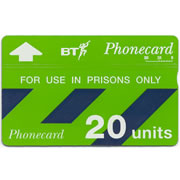HM Prison Telecom Portugal 120unit Overprint
Telephone cards were used in Prisons throughout England, Scotland, Wales and Northern Ireland, to enable inmates to make telephone calls. While millions of cards were issued and most of these were very much generic, there are often exceptions to the rule. The article below first appeared in the Dec 1992/Jan 1993 issue of Phonecard Collector recounts one such exception.
Read more about telephone cards that were issued for use in HM Prisons.
Oh yes, and you thought I had to be joking! - might well be the reaction of most collectors and dealers if I had told them that at least one BT Phonecard in use had originally started life as a Phonecard for a completely different country.
Yes, strange to relate, this is actually the case where one of the H.M. Prison cards is concerned.
News of this very peculiar occurrence first assailed my ears when our ex-treasurer, Chris Dennison, rang me to inform me that he had found some examples of a recent HMP 20unit cards, with green optical strip, from two particular controls, which showed obvious signs that the design had been printed over an already existing design. He had even gone as far as being able to identify what the original card had been - a (wait for it) - 120unit Crediphone card from Portugal!!
Examination of these cards show the presence of a large irregular circle at bottom left, plus an additional "arrow" to the right of the regular arrow with "20" in it. Needless to say, both these signs are visible to the naked eye, showing through the HMP design from underneath. The control numbers are 262G and 262L.

Once his find had been thoroughly checked out and verified it was time to consider all the possible ramifications this unprecedented discovery might have.
Whilst of obvious importance to collectors, these cards might well prove to be the indication of some form of security breach in the special prison telephone system, established by BT for the Home Office, and it would not be too clever an idea to go around, offering these cards to all collectors indiscriminately. After all, what if ordinary Portuguese cards were found to work in cardphones within H.M. Prisons? Could anyone guarantee that, if so, no collector had friends or relatives "inside" who might well try to take advantage of such information? It was plain that, whether we liked it or not, such news would "leak" in due course, so it become evident that we had to do something.
Accordingly, I had no alternative but to involve the TCC Committee, and acting on the advice on the advice of a quorum of committee members, I formally advised the Production Manager at Landis & Gyr of our findings, stressing our concern over the security aspect of such information, and stating that we would not publish anything on this matter until any necessary steps had been taken to obviate any possible security breach. Suffice it to say that he quickly contacted me, and gave us permission to publish, informing us that the cards in question were "extras" left-over from a previous print-run. BT had contacted Landis & Gyr asking if they could print some more HMP cards, and they had told BT they had these cards in stock, and quoted BT some discontinued price if they agreed to take the lot. This, BT had agreed to.
So... after all, our worries were unfounded. It only remains to say that we now have at least one very peculiar HMP Phonecard!!
Whoever said collecting bits of plastic was dull?? (Peter Harradine)
 HM Prison Phonecards
HM Prison Phonecards
The story of the HMP Prison Phonecard Portuguese overprint is just one part of the interesting story of H.M. Prison telephone cards.
Read more about the story and view the different Prison Phonecard designs that were issued.
Last updated: 2nd January 2026
Popular Pages
Collector Shop
Site Maps
TelephoneCardCollector.com © 2013-2026
Please do NOT copy any content without prior consent, thank you.

